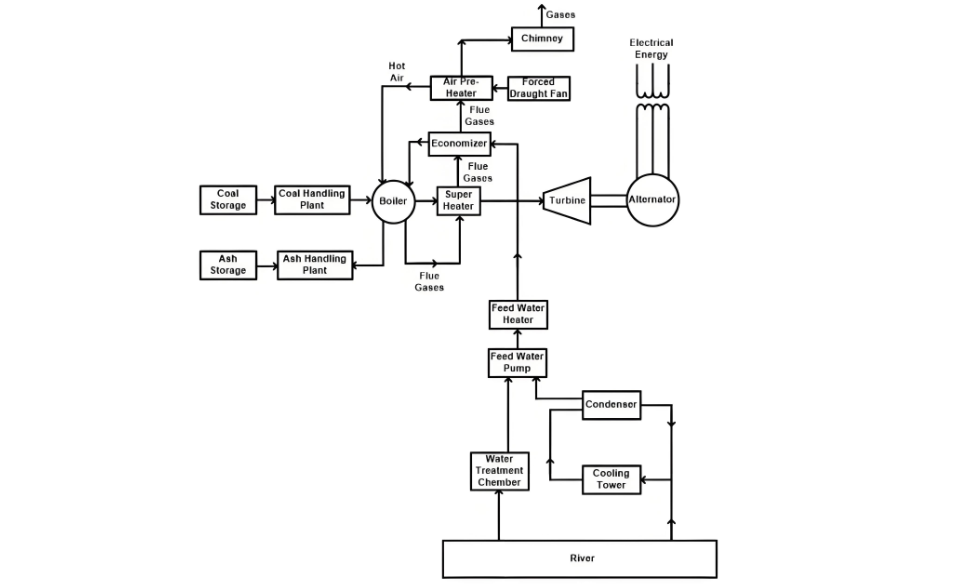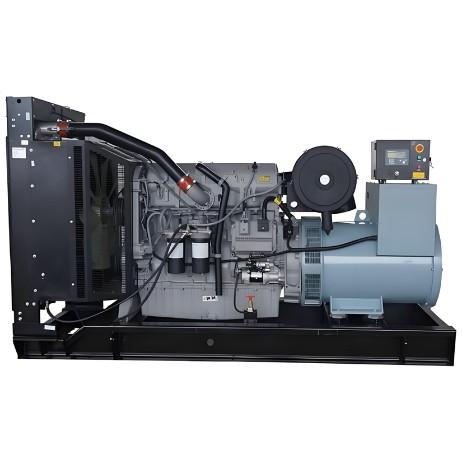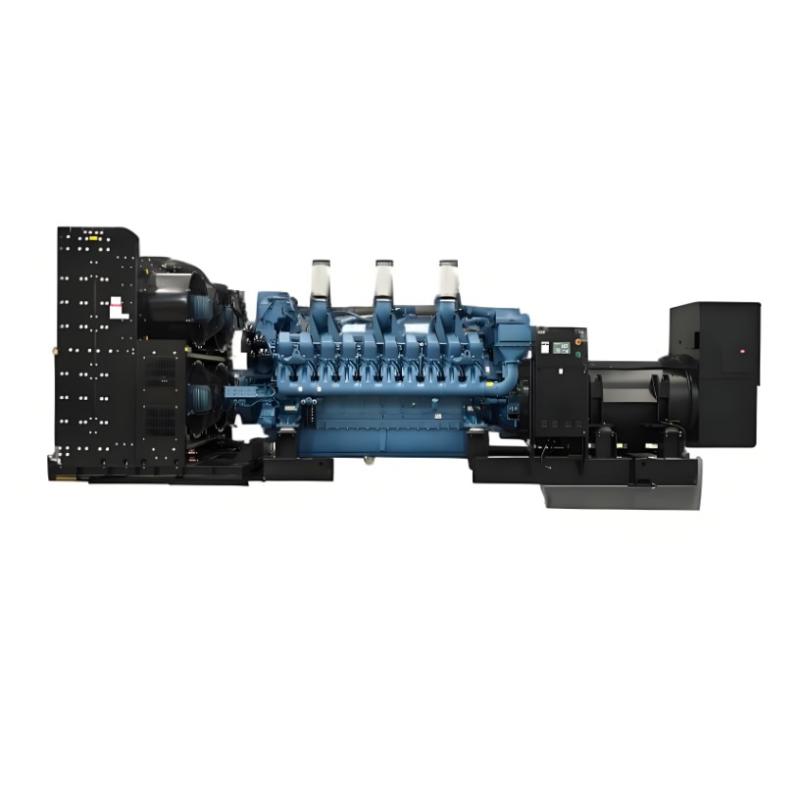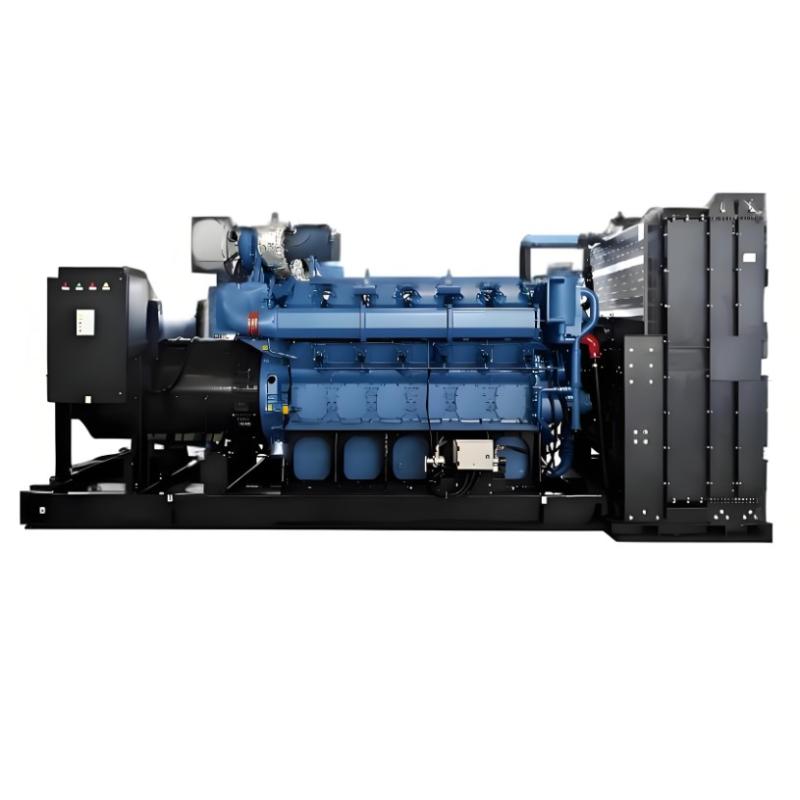Ano ang Thermal Power Plant?
Ang batas ng pagkonserva sa enerhiya nagsulti nga ang enerhiha dili mahimo o mabag-o; kini lang mausab gikan sa usa ka porma ngadto sa uban. Ang elektrikal nga enerhiha, partikular, mahimong makapahimulos gikan sa pipila ka mga pinanggugohan sa enerhiha. Ang mga pasilidad nga gidisenyuha aron makagenera og malubog nga skala sa elektrikal nga enerhiha kasagaran gigamit ingon sa mga power plant o power stations.
Ang thermal power plant usa ka tipo sa power generation facility nga nag-usab sa heat energy ngadto sa elektrikal nga enerhiha. Ang heat energy alang sa mga plants mahimong magdagan gikan sa pipila ka mga pinanggugohan, kasinod ang coal, diesel, biofuels, solar energy, ug nuclear energy. Bagama't ang termino "thermal power plant" teknikal nga makapakatakos sa mga plants nga gigamit sa pipila ka mga pinanggugohang heat, kasagaran kini gitumong sa mga plants nga gipahimulos ang heat gikan sa coal. Konsekwente, ang mga thermal power plants gitawag usab ingon sa conventional power generation systems. Kasagaran sila gitawag usab ingon sa steam-turbine power plants o coal-fired power plants, nga nagpakita sa primary fuel source ug ang key energy-conversion mechanism nga gigamit.
Pagsulay sa Thermal Power Plant
Ang mga thermal power plants nagoperar basi sa Rankine cycle, isip fundamental thermodynamic cycle aron mapag-usab ang heat ngadto sa mechanical work, nga pagkatapos gigamit aron makagenera og electricity. Ang sumusunod nga one-line diagram o layout sa thermal power plant naghatag og visual representation sa iyang operational components ug proseso.

Ang Interior nga Pagsulay ug Mga Komponente sa Thermal Power Plant
Operational Process
Ang mga thermal power plants nagkinahanglan og daghang fuel, kasagaran ang coal. Tungod sa malubog nga volume nga kinahanglan, ang coal kasagaran gitransporta pinaagi sa tren ug gitipigan sa dedicated fuel storage areas. Sa unang panahon, ang raw coal masayo pa para direkta nga gamiton sa boiler. Aron matubos kini, gi-feed kini sa usa ka crusher, nga magreduksyon kini ngadto sa mas liyutan ug mas manageable nga mga butang bago igconvey sa boiler.
Sumala sa coal, ang significant nga amount sa tubig importante para sa steam production sa loob sa boiler. Bago makasulod sa sistema, ang tubig gigamit sa usa ka treatment process. Igi-pass kini sa pipila ka mga filter aron matangtang ang impurities ug anumang dissolved air, siguradohon ang iyang purity. Pagkahuman mitreat, ang tubig idirektso sa boiler drum. Sa loob sa boiler drum, ang heat giproduce sa combustion sa coal gitransfer sa tubig. Sumala, ang tubig magpadayon sa phase change ug magtransforma ngadto sa steam.
Ang giproduce nga steam high-pressure ug high-temperature, gihatagan kini og ideal para sa power generation. Kini pagkatapos igchannel sa superheater, diin gitawasan pa ang iyang temperature aron mapataas ang iyang thermal energy. Ang superheated steam pagkatapos igdirect ha turbine blades. Kon ang steam mogflow ha turbine blades, ang iyang thermal energy gi-usab ngadto sa mechanical rotational energy sa turbine.
Ang turbine mechanically coupled sa alternator pinaagi sa common shaft. Kon ang turbine mogrotate, it drives the rotor of the alternator. Ang alternator, sa katun-aw, gi-usab kini ngadto sa electrical energy. Aron efektibong transmiton ang generate nga electrical energy ha long distances, igpass kini ha transformer, diin gitawasan ang voltage. Ang high-voltage electricity pagkatapos igsend ha transmission lines aron mobati sa end-users, o loads, sa power grid.
Pagkatapos mogpas ha turbine, ang steam, kasagaran na lower pressure ug temperature, igdirect ha condenser. Ha condenser, ang cold water mocirculate ha steam, mosulyapan kini mogcondense balik ngadto sa liquid state. Kini nga condensation process nagsulay sa remaining heat ha steam, effectively reducing its pressure ug temperature. By recovering the water in this way, the efficiency of the power generation cycle is enhanced.
Ang condensed water pagkatapos igpump back ha boiler using a feedwater pump, ready to be heated and converted into steam once again, thus completing the cycle. Meanwhile, ang ash generated as a by-product of coal combustion is removed from the boiler furnace. Proper disposal of this ash is crucial to prevent environmental damage. Additionally, during the combustion of coal in the boiler, flue gases are produced and are released into the atmosphere through the chimney.
Key Components
A thermal power plant comprises several integral components that work in harmony to facilitate the power generation process:
Boiler: The heart of the thermal power plant, where coal combustion occurs, and heat is transferred to water to produce steam.
Turbine: Converts the thermal energy of high-pressure steam into mechanical rotational energy.
Super-heater: Raises the temperature of the steam produced in the boiler, increasing its energy content for more efficient power generation.
Condenser: Condenses the exhaust steam from the turbine back into water, recovering heat and maintaining the cycle's efficiency.
Economizer: Preheats the feedwater using the heat from the flue gases, reducing the overall energy consumption of the boiler.
Feedwater Pump: Circulates the condensed water from the condenser back to the boiler, ensuring a continuous supply for steam production.
Alternator: Transforms the mechanical energy from the turbine into electrical energy, which can be distributed through the power grid.
Chimney: Disperses the flue gases produced during coal combustion into the atmosphere in a controlled manner.
Cooling Tower: Facilitates the cooling of the water used in the condenser, allowing it to be recycled and reused in the power generation process.

Components, Site Selection, and Efficiency of Thermal Power Plants
Key Components of Thermal Power Plants
Boiler
Pulverized coal, accompanied by preheated air, is fed into the boiler, which serves as the core component for generating high-pressure steam. Its primary function is to transform the chemical energy stored in coal into thermal energy through the combustion process. As coal burns inside the boiler, it generates intense heat, reaching temperatures sufficient to convert water into steam. The size of the boiler is directly determined by the heat requirements of the thermal power plant. There is a diverse range of boilers utilized in thermal power plants, including Haycock and wagon top boilers, firetube boilers, Cylindrical fire-tube boilers, and water-tube boilers, each with its own design characteristics and operational advantages.
Turbine
High-pressure and high-temperature superheated steam, produced by the boiler, is directed towards the turbine. When this steam strikes the turbine blades, it sets the turbine in motion. The turbine is a sophisticated mechanical device specifically engineered to convert the thermal energy of steam into rotational kinetic energy. Mechanically coupled to an alternator via a shaft, the turbine's rotation drives the alternator's rotor. Once the steam passes through the turbine, its temperature and pressure decrease, and it is then channeled to the condenser for further processing.
Super-heater
In a steam turbine-based power generation system, superheated steam is essential for efficient turbine operation. Wet and saturated steam, emerging from the boiler, is fed into the super-heater. This device plays a crucial role in transforming the steam into dry and superheated steam, significantly increasing its thermal energy content. Among all the components of a thermal power plant, the super-heater operates at the highest temperature. Three main types of superheaters are commonly employed: convection superheaters, which transfer heat through convection currents; radiant superheaters, which rely on radiant heat transfer; and separately fired superheaters. By enhancing the temperature of the steam generated by the boiler, the super-heater boosts the overall efficiency of the power generation process.
Condenser
After the steam has passed through the turbine and its temperature and pressure have dropped, the exhaust steam is recycled back into the power generation cycle. To optimize the turbine's efficiency, it is necessary to condense this steam, creating and maintaining a proper vacuum. The condenser achieves this by reducing the operating pressure, thereby increasing the vacuum level. This increase in vacuum causes the volume of steam to expand, allowing for more work to be extracted from the steam in the turbine. As a result, the overall efficiency of the power plant improves, with a corresponding increase in the turbine's output.
Economizer
The economizer is a specialized heat exchanger designed to minimize energy consumption within the power plant. Flue gases, rich in thermal energy, are exhausted from the boiler into the atmosphere. The economizer harnesses the heat from these flue gases to preheat the water. Water recovered from the condenser is pumped to the economizer by the feedwater pump. Here, it absorbs the heat from the flue gases, raising its temperature before entering the boiler. By reusing the waste heat of the flue gases, the economizer significantly enhances the overall efficiency of the power generation cycle.
Feedwater Pump
The feedwater pump is responsible for supplying water to the boiler. The water source can be either the condensed water from the condenser or fresh water. This pump increases the water pressure, ensuring a continuous and adequate supply to meet the boiler's requirements. Commonly, feedwater pumps are of the centrifugal or positive displacement type, each offering distinct advantages in terms of performance and efficiency.
Alternator
Mechanically connected to the turbine via a shared shaft, the alternator plays a pivotal role in the power generation process. As the turbine rotates under the force of the steam, it drives the alternator's rotor. This rotation induces an electromagnetic field, generating electrical energy. In essence, the alternator serves as a converter, transforming the kinetic energy of the turbine's rotation into electrical energy that can be transmitted and distributed through the power grid.
Chimney
In most thermal power plants that utilize coal as fuel, the combustion process in the boiler generates flue gases. The chimney provides a pathway for these flue gases to be safely discharged into the atmosphere. Its operation is based on the principles of natural draft and the stack effect. Hot air, being less dense, rises, creating a draft that draws the flue gases upwards. The height of the chimney is a critical factor; taller chimneys generate a stronger draft, facilitating more efficient gas dispersion.
Cooling Tower
True to its name, the cooling tower is primarily used to dissipate waste heat into the atmosphere. Employing various heat transfer methods, the cooling tower allows the heat from the water to evaporate, leaving behind cooler water that can be reused in the power generation cycle. Water condensed from the steam in the condenser is channeled to the cooling tower. Forced-flow cooling towers are commonly used in thermal power plants, where air is circulated from the bottom to the top of the tower, enhancing the heat transfer efficiency.
Site Selection Criteria for Thermal Power Plants
Availability of Fuel
Given that coal is the predominant fuel in most thermal power plants and the substantial quantity required for large-scale electricity generation, locating the power plant near a coal mine is highly advantageous. This proximity significantly reduces transportation costs, making the power generation process more economically viable.
Transportation Facility
Thermal power plants house numerous large-sized machinery and equipment. Therefore, the plant site must be selected in an area with excellent transportation infrastructure. Reliable rail or road transportation is essential for the efficient movement of coal, as well as for the delivery of new equipment and the transportation of workers, technicians, and engineers. Additionally, the availability of public transport in the vicinity ensures convenient access for the plant's workforce.
Availability of Water
A thermal power plant requires a massive amount of water to produce high-pressure and high-temperature steam. Consequently, the plant should be situated near a riverbank or in a location with a consistent and abundant water supply to meet the continuous demand for water used in steam generation and cooling processes.
Availability of Land
Constructing a thermal power plant demands a large expanse of land. Moreover, the land cost should be reasonable. When choosing the site, provisions for future expansion should also be considered. Since the plant houses heavy machinery, the ground must have sufficient load-bearing capacity, and a robust foundation is essential to support the equipment.
Distance from Populated Areas
Thermal power plants emit flue gases, ash, dust, and smoke during operation, all of which pose significant health risks to humans and can cause environmental damage to the surrounding atmosphere and land. To minimize these impacts, the plant should be located far from urban areas, residential communities, and agricultural farms. Additionally, the noise generated by the plant's machinery, such as alternators, transformers, fans, and turbines, further necessitates its placement in a remote location.
Ash Disposal Facility
Coal combustion results in the generation of ash, accounting for approximately 30-40% of the total coal consumption. Proper ash disposal is of utmost importance. Ash is collected from the bottom of the boiler furnace, and a significant portion of it is carried away by the flue gases. To manage ash effectively, two main ash-handling systems are employed: the bottom ash handling system and the fly ash handling system. The plant site should have suitable facilities for the safe and environmentally friendly disposal of this ash.
Proximity to Load Center
The electrical energy generated by the alternator is stepped up in voltage by a power transformer before being transmitted to the load center through transmission lines. Locating the thermal power plant near the load center reduces transmission costs and losses, ensuring a more efficient and cost-effective distribution of electricity.
Efficiency of Thermal Power Plants
In a thermal power plant, electricity generation involves multiple energy conversion stages. First, the chemical energy of coal is transformed into thermal energy. This thermal energy is then converted into kinetic or mechanical energy, which is finally converted into electrical energy. Due to these multiple energy conversion processes, the overall efficiency of thermal power plants is relatively low, typically ranging from 20-29%.
The efficiency of a thermal power plant is influenced by various factors, including the plant's size and the quality of coal used. A significant amount of heat energy is lost in the condenser during the power generation process. There are two primary types of efficiency metrics used to evaluate thermal power plants:
Thermal Efficiency
Thermal efficiency is defined as the ratio of the mechanical energy, expressed in heat equivalent terms, available at the turbine to the total heat energy released during the combustion of coal in the boiler. It measures the effectiveness of converting the heat energy from coal combustion into useful mechanical work in the turbine.

Thermal Efficiency
Thermal power plants typically achieve an approximate thermal efficiency of 30%. A significant portion, around 50% of the total heat energy generated, is dissipated as waste within the condenser. The remaining heat energy is lost through various other channels, such as in the flue gases emitted from the chimney and the ash produced during coal combustion. This substantial heat loss in the condenser and elsewhere underscores the inherent inefficiencies of traditional thermal power generation processes.
Overall Efficiency
The overall efficiency of a thermal power plant is calculated as the ratio of the heat equivalent of the electrical output to the total heat released during the combustion of coal. This metric provides a comprehensive measure of the plant's performance, encompassing all stages of energy conversion from the initial chemical energy stored in coal to the final electrical energy delivered to the grid. It reflects how effectively the plant can transform the energy in coal into usable electrical power, taking into account losses that occur at every step of the complex power generation process.

Overall Efficiency of Thermal Power Plants
The overall efficiency of a thermal power plant encapsulates all the losses that occur throughout the entire power-generation cycle. This includes inefficiencies during coal combustion, heat transfer processes, steam turbine operation, and crucially, the performance of the alternator, which converts mechanical energy into electrical energy. Each of these stages contributes to the overall energy loss, ultimately determining the proportion of the initial energy in the coal that is successfully transformed into usable electrical power.
The overall efficiency of a thermal power plant is closely tied to its size and power-generation capacity, typically measured in megawatts (MW). As a general rule, there is a direct correlation between the capacity of a thermal power plant and its efficiency: plants with lower capacities tend to exhibit lower overall efficiencies. Smaller plants often lack the economies of scale and optimized design features that larger plants possess, resulting in higher relative energy losses at each stage of the power-generation process. This means that a greater proportion of the energy from the fuel is wasted, reducing the amount of electricity that can be produced per unit of fuel consumed.



























